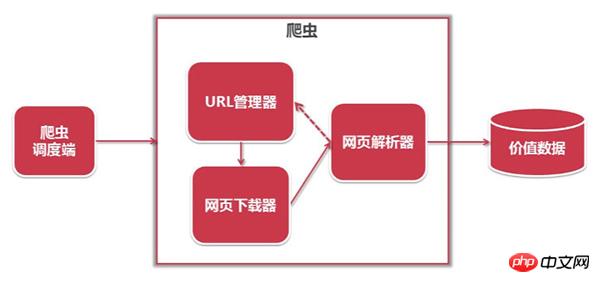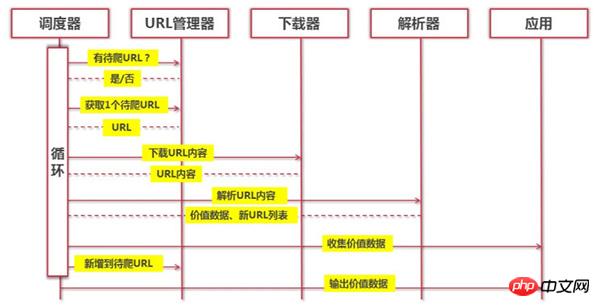Today we will explain the basic conceptual knowledge of python. Many friends who are new to python have many questions. What is a python crawler? Then why is python called a crawler?
What is a python crawler?
Before entering the article, we first need to know what a crawler is. A crawler, that is, a web crawler, can be understood as a spider crawling on the Internet. The Internet is like a big web, and a crawler is a spider crawling around on this web. If it encounters its prey ( resources required), then it will grab it. For example, if it is crawling a web page, and it finds a path in this web, which is actually a hyperlink pointing to the web page, then it can crawl to another web page to obtain data. If it is not easy to understand, you can actually understand it through the following picture:

Because of the scripting characteristics of python, python is easy to configure. The processing of characters is also very flexible, and python has a rich network crawling module, so the two are often linked together. Python crawler development engineers start from a certain page of the website (usually the home page), read the content of the web page, find other link addresses in the web page, and then use these link addresses to find the next web page. This cycle continues until this Until all web pages of the website have been crawled. If the entire Internet is regarded as a website, then web spiders can use this principle to crawl all web pages on the Internet.
Crawlers can crawl the content of a website or application and extract useful value. You can also simulate user operations on browsers or App applications to implement automated procedures. The following behaviors can be achieved with crawlers:
vote-grabbing artifact
voting artifact
Prediction (stock market prediction , box office prediction)
National Sentiment Analysis
Social Relationship Network
As mentioned above, we can think that
crawlers generally refer to the crawling of network resources, and because Python's scripting features are not only easy to configure, but also very flexible in character processing. In addition, Python has rich web crawling modules, so the two are often linked together. This is why python is called a crawler.
Why is python called a crawler? As a programming language, Python is pure free software. It is deeply loved by programmers for its concise and clear syntax and forced use of whitespace characters for statement indentation. . To give an example: to complete a task, a total of 1,000 lines of code need to be written in C language, 100 lines of code in Java, and only 20 lines of code in Python. If you use Python to complete programming tasks, you will write less code, and the code will be concise, short, and more readable. When a team is developing, it will be faster to read other people's code, and the development efficiency will be higher, making the work more efficient.
This is a programming language that is very suitable for developing web crawlers, and compared to other static programming languages, Python’s interface for grabbing web documents is simpler; compared to other dynamic script languages, Python’s urllib2 package Provides a relatively complete API for accessing web documents. In addition, there are excellent third-party packages in python that can efficiently implement web page crawling, and can complete the tag filtering function of web pages with very short codes.
The structure of the python crawler is as follows:
 ##1. URL manager: manages the URLs to be crawled Collection and crawled URL collection, send the URL to be crawled to the web page downloader;
##1. URL manager: manages the URLs to be crawled Collection and crawled URL collection, send the URL to be crawled to the web page downloader;
#2. Web page downloader: crawl the web page corresponding to the URL and store it as a string. Send it to the web page parser;
3. Web page parser: parse out valuable data, store it, and add the url to the URL manager.
The workflow of python is as follows:
 (The Python crawler determines whether there is a URL to be crawled through the URL manager. If there is a URL to be crawled, it is passed to the downloader through the scheduler, the URL content is downloaded, and sent to the parser through the scheduler, the URL content is parsed, and the value data and new URL list are passed to the application through the scheduler, and the value is output Information process.)
(The Python crawler determines whether there is a URL to be crawled through the URL manager. If there is a URL to be crawled, it is passed to the downloader through the scheduler, the URL content is downloaded, and sent to the parser through the scheduler, the URL content is parsed, and the value data and new URL list are passed to the application through the scheduler, and the value is output Information process.)
Python is a programming language that is very suitable for developing web crawlers. It provides modules such as urllib, re, json, pyquery, etc., and it also has many established frameworks, such as Scrapy framework, PySpider crawler system, etc., which itself is very It is simple and convenient, so it is the preferred programming language for web crawlers! I hope this article can provide some help to friends who have just come into contact with the python language.
The above is the detailed content of What is a python crawler? Why is python called a crawler?. For more information, please follow other related articles on the PHP Chinese website!

Hot AI Tools

Undress AI Tool
Undress images for free

Undresser.AI Undress
AI-powered app for creating realistic nude photos

AI Clothes Remover
Online AI tool for removing clothes from photos.

Clothoff.io
AI clothes remover

Video Face Swap
Swap faces in any video effortlessly with our completely free AI face swap tool!

Hot Article

Hot Tools

Notepad++7.3.1
Easy-to-use and free code editor

SublimeText3 Chinese version
Chinese version, very easy to use

Zend Studio 13.0.1
Powerful PHP integrated development environment

Dreamweaver CS6
Visual web development tools

SublimeText3 Mac version
God-level code editing software (SublimeText3)

Hot Topics
 How does Python's unittest or pytest framework facilitate automated testing?
Jun 19, 2025 am 01:10 AM
How does Python's unittest or pytest framework facilitate automated testing?
Jun 19, 2025 am 01:10 AM
Python's unittest and pytest are two widely used testing frameworks that simplify the writing, organizing and running of automated tests. 1. Both support automatic discovery of test cases and provide a clear test structure: unittest defines tests by inheriting the TestCase class and starting with test\_; pytest is more concise, just need a function starting with test\_. 2. They all have built-in assertion support: unittest provides assertEqual, assertTrue and other methods, while pytest uses an enhanced assert statement to automatically display the failure details. 3. All have mechanisms for handling test preparation and cleaning: un
 How can Python be used for data analysis and manipulation with libraries like NumPy and Pandas?
Jun 19, 2025 am 01:04 AM
How can Python be used for data analysis and manipulation with libraries like NumPy and Pandas?
Jun 19, 2025 am 01:04 AM
PythonisidealfordataanalysisduetoNumPyandPandas.1)NumPyexcelsatnumericalcomputationswithfast,multi-dimensionalarraysandvectorizedoperationslikenp.sqrt().2)PandashandlesstructureddatawithSeriesandDataFrames,supportingtaskslikeloading,cleaning,filterin
 What are dynamic programming techniques, and how do I use them in Python?
Jun 20, 2025 am 12:57 AM
What are dynamic programming techniques, and how do I use them in Python?
Jun 20, 2025 am 12:57 AM
Dynamic programming (DP) optimizes the solution process by breaking down complex problems into simpler subproblems and storing their results to avoid repeated calculations. There are two main methods: 1. Top-down (memorization): recursively decompose the problem and use cache to store intermediate results; 2. Bottom-up (table): Iteratively build solutions from the basic situation. Suitable for scenarios where maximum/minimum values, optimal solutions or overlapping subproblems are required, such as Fibonacci sequences, backpacking problems, etc. In Python, it can be implemented through decorators or arrays, and attention should be paid to identifying recursive relationships, defining the benchmark situation, and optimizing the complexity of space.
 How can you implement custom iterators in Python using __iter__ and __next__?
Jun 19, 2025 am 01:12 AM
How can you implement custom iterators in Python using __iter__ and __next__?
Jun 19, 2025 am 01:12 AM
To implement a custom iterator, you need to define the __iter__ and __next__ methods in the class. ① The __iter__ method returns the iterator object itself, usually self, to be compatible with iterative environments such as for loops; ② The __next__ method controls the value of each iteration, returns the next element in the sequence, and when there are no more items, StopIteration exception should be thrown; ③ The status must be tracked correctly and the termination conditions must be set to avoid infinite loops; ④ Complex logic such as file line filtering, and pay attention to resource cleaning and memory management; ⑤ For simple logic, you can consider using the generator function yield instead, but you need to choose a suitable method based on the specific scenario.
 What are the emerging trends or future directions in the Python programming language and its ecosystem?
Jun 19, 2025 am 01:09 AM
What are the emerging trends or future directions in the Python programming language and its ecosystem?
Jun 19, 2025 am 01:09 AM
Future trends in Python include performance optimization, stronger type prompts, the rise of alternative runtimes, and the continued growth of the AI/ML field. First, CPython continues to optimize, improving performance through faster startup time, function call optimization and proposed integer operations; second, type prompts are deeply integrated into languages ??and toolchains to enhance code security and development experience; third, alternative runtimes such as PyScript and Nuitka provide new functions and performance advantages; finally, the fields of AI and data science continue to expand, and emerging libraries promote more efficient development and integration. These trends indicate that Python is constantly adapting to technological changes and maintaining its leading position.
 How do I perform network programming in Python using sockets?
Jun 20, 2025 am 12:56 AM
How do I perform network programming in Python using sockets?
Jun 20, 2025 am 12:56 AM
Python's socket module is the basis of network programming, providing low-level network communication functions, suitable for building client and server applications. To set up a basic TCP server, you need to use socket.socket() to create objects, bind addresses and ports, call .listen() to listen for connections, and accept client connections through .accept(). To build a TCP client, you need to create a socket object and call .connect() to connect to the server, then use .sendall() to send data and .recv() to receive responses. To handle multiple clients, you can use 1. Threads: start a new thread every time you connect; 2. Asynchronous I/O: For example, the asyncio library can achieve non-blocking communication. Things to note
 How do I slice a list in Python?
Jun 20, 2025 am 12:51 AM
How do I slice a list in Python?
Jun 20, 2025 am 12:51 AM
The core answer to Python list slicing is to master the [start:end:step] syntax and understand its behavior. 1. The basic format of list slicing is list[start:end:step], where start is the starting index (included), end is the end index (not included), and step is the step size; 2. Omit start by default start from 0, omit end by default to the end, omit step by default to 1; 3. Use my_list[:n] to get the first n items, and use my_list[-n:] to get the last n items; 4. Use step to skip elements, such as my_list[::2] to get even digits, and negative step values ??can invert the list; 5. Common misunderstandings include the end index not
 Polymorphism in python classes
Jul 05, 2025 am 02:58 AM
Polymorphism in python classes
Jul 05, 2025 am 02:58 AM
Polymorphism is a core concept in Python object-oriented programming, referring to "one interface, multiple implementations", allowing for unified processing of different types of objects. 1. Polymorphism is implemented through method rewriting. Subclasses can redefine parent class methods. For example, the spoke() method of Animal class has different implementations in Dog and Cat subclasses. 2. The practical uses of polymorphism include simplifying the code structure and enhancing scalability, such as calling the draw() method uniformly in the graphical drawing program, or handling the common behavior of different characters in game development. 3. Python implementation polymorphism needs to satisfy: the parent class defines a method, and the child class overrides the method, but does not require inheritance of the same parent class. As long as the object implements the same method, this is called the "duck type". 4. Things to note include the maintenance






